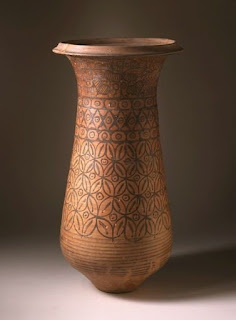From ancient Indian history questions on Indus Valley Civilization was always asked. By memorizing these static information on IVC you are not going to miss 1 or 2 marks. It also Increases your knowledge on IVC.
Important and exhaustive information of IVC are as follows-
1. Charles Masson was the first person to notice the ruins of IVC In 1826. "Narrative of Various Journeys in Baluchistan, Afghanistan, and the Punjab" book has been published by him in 1842.
2. The IVC was first identified in 1921 at Harappa in the Punjab region first excavated in 1920 and 1921 by the Archaeological Survey of India, led by Rai Bahadur Daya Ram Sahni.
3. In 1922 at Mohenjo-daro (Mohenjodaro), near the Indus River in the Sindh (Sind) region has been excavated by Rakhal Das Bannerjee.
4. Ghaggar-Hakra basin has the largest concentration of Indus sites been found.
5. A copper chariot of Indus times was discovered at Daimabad.
6. At Dholavira Rock cut architecture in Indus culture context been found.
7. The people of the Indus Valley Civilization usually built their houses of Baked Bricks.
8. Lothal site of Indus has the evidence of a dockyard in the city.
9. The earliest evidence of cattle herding in south Asia comes from the Indus River Valley site of Mehrgarh dated to 7,000 YBP(year before present).
10. From the site Mohanjodaro the Great Granary, the Great Bath, a piece of Woven Cotton and Bronze Dancing Girl was found.
11. Meaning of Mohanjodro in Sindhi language is " the mount of the dead".
12. "Meluha" was the ancient name famous for the Indus region.
13. Pashupati was the chief male deity of the Indus People.
14. "Mother Goddess" was the chief female deity of the Indus People.
15. "Pipal (fig) tree was worshipped by Indus people.
16. Town planning was the main characteristic of the Indus valley civilization.
17. Due to Evidence of COPPER the Indus valley civilization is known as Pre-aryan civilization.
18. Agriculture was the main occupation of the Indus valley people.
19. Rice cultivation is associated with Lothal site of Indus valley.
20. Indus people has the trade relations with Mesopotamian civilization.
21. Use of plough has been evidenced at Kalibangan Excavation of Indus valley.
22. The script of Indus valley civilization is still undeciphered.
23. The swastika symbol first appears in the archaeological record around 3000 BCE in the Indus Valley Civilization.
24. The precise meter scale discovered by Ernest Mackay in the 1930-31 at Mohenjo-daro.
25. Circular stones were used at Dholavira for building houses.
26. The houses built in Indus sites has no windows except Lothal, windows were found.
27. The seals of Indus depicts Unicorn, Elephant, Tiger, Rhino, Antelope, Crocodile.
28. Pashupati Seal has been found from Mohanjodaro.
29. Water Harvesting System was discovered at Dholavira.
30. Dholvira was the only City divided into three parts.
31. Kalibangan and Banawali have the evidence of proto-Harappan and Harappan cultural phases.
32. Lothal has the first manmade port in the world.
33. The Indus People has internal trade relations withith Saurashtra, Maharastra, South India, Rajasthan, ports of western UP.
34. Indus valley was aware of the metals Copper, Silver, Gold, Jade, Lapis Lazulli, Lead. Tin, Ingot (Lead+Silver), Electrum (Silver & Gold).
35. Main crops of Indus people was Wheat & Barley. Others Peas, Rice, Linseed, Mustard, Cotton, Dates.
Rice husk has been found from Lothal & Rangpur.
36. Harappans used the weapons Spears, Axes, Arrow-heads.
37. Stone cut water reservoir was discovered at Dholavira site.
38. The southern most site of the Indus valley civilisation is Daimabad in Maharashtra.
39. The IVC extended from Pakistan's Balochistan in the west to India's western Uttar Pradesh in the east, from northeastern Afghanistan in the north to India's Gujarat state in the south.
40. Rakhigarhi of Haryana is the biggest Indus valley civilization site even biggesr than Mohenjodaro.
41. The Indus Valley Civilization has yielded evidence of dentistry being practiced by 4,000 years to around 7000 B.C.
Variety of Pleasing Design — Horizontal strips, Check, Chess-Board Pattern, Interesecting Circles (Pattern exclusively found), Leaves & Petals, Natural Motif — Birds, Fish, Animals, Plants, Human Figure — Rare (A Man & A Child found from Harappa), Triangles.
 |
| Seal of Harappa |
 |
| Working Tools Of IVC |
 |
| Terracotta Pottery |
 |
| Mother Goddess |
Dancing Girl
 |
| The Great Bath |
 |
| Terracotta Pots |
 |
| Pashupati |
 |
 |
| Statue of Beard Man |
 |
| Seals Found In IVC |
 |
| Pashupati |
 |
| Gaming Board Dices Tools |
 |
| Painted Pottery |
 |
| Pipal Tree Design |
 |
| Unicorn |
 |
| Unicorn Seal |
 |
| Chess Like Game IVC |
 |
| Mother Goddess Depiction |



Nice....
ReplyDeleteThanks 😊
DeleteGood effort 👌Excellent 👌❤
ReplyDeleteThank you 😊❤️
Delete